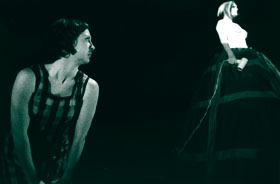Double Vision, strong focus
Daryl Buckley: Maryanne Lynch, Double Vision

Lisa O’Neill, Vanessa Tomlinson, Double Vision
photo Maree Cunnington
Lisa O’Neill, Vanessa Tomlinson, Double Vision
An image of the soles of Lisa O’Neill’s feet has stayed with me for some time after seeing Double Vision. Their wrinkled, abstruse folds seemed to convey an interaction between the interior secretive world and something made far more explicit, a dynamic that framed the more complex cross artform elements in this work. The manner in which those feet, seemingly possessed, drove the splayed torso of O’Neill across the stage confirmed the marionette-like status and powerlessness of that childlike figure. The feet moved in the direction of a little heart shaped red pincushion, a gift referred to in Maryanne Lynch’s text as given by one ill-fated mother to an ill-fated daughter. The child moves to re-embrace the mother. A memory revolving around the nostalgic symbols of pathos, love and loss surges hopefully towards some kind of reconciliation.
Double Vision, a performance-installation driven by writer-director Lynch, involved singer Christine Johnson, composer John Rodgers, percussionist Vanessa Tomlinson, dancer Lisa O’Neill, sound designer Brett Cheney, designer Selene Cochrane and lighting designer Matt Scott. The performance and creative development was funded and resourced principally through the Queensland Performing Arts Trust. Normally associated with mainstream productions such as the Edinburgh Military Tattoo, this kind of commitment from QPAT to contemporary Australian work merits high praise.
The stated intention of the work is “an exploration of motherhood—as viewed by daughters and lived by mothers.” Lynch is fascinated with iconic crime and, in this instance, Double Vision utilises 2 texts drawn from mothers whose lives are marked by the murder and misfortunes of their children and the subsequent judgements of society: Mary Murphy of the Gatton murders incident and Bilynda Murphy of Moe in Victoria.
I have often seen performance installations or cross artform projects which dissolve readily into a set of perceptions: ‘oh, the musician is moving an object again or playing at being a visual artist.’ Thankfully that was not the case here. The dense and complex structure, as the title suggests, allowed the audience to shift their focus between multiple events, in and out of the visual details of any one moment or the physical interiority of any one sound. I appreciated the ambition.
Two crinoline-like structures dominated the stage. One seemingly eviscerated and ribbed provided a birdcage littered with various percussion instruments and 3 gutted pianos, symbols of female domesticity, of soirees to entertain friends and family, the mark of bourgeois education and learning. They seemed and sounded rotten. Tomlinson acted upon their destroyed innards as a graveyard caretaker might to an old wooden coffin.
At the other end, Christine Johnson was immobilised upon a covered crinoline that thrust her upwards towards the lighting grid. The head of Johnson, like the feet of O’Neill, seemed divorced from the rest of her body. But her voice readily enveloped the audience and in one section the tearing agonised refrain of a mother seeking her lost child hammered out. The folds of the crinoline seemed as if the child could have hidden there and emerged at any moment. This was not to be. Mary Murphy is quoted in the text: “The pain is piercing me until I could die.” These were the moments that attempted to pierce the audience, to give some intimation of what that pain could be.
Recorded voices of women and children told their stories. A long necklace of jewelled lights snaked out behind one of the crinolines. A balloon was performed upon. A lot of small details, the symbolic minutiae of torn lives, emerged when I appreciated this work in hindsight. The strength of Double Vision lay in a cohesive integrity that refused to signal every moment to the audience or tell them what to think.
This is a group of artists that I would like to see together again in a future collaboration.
Double Vision, writer/director Maryanne Lynch and collaborators, Merivale St Studios, Brisbane, July 10-14
Lisa O’Neill is also appearing in l’attitude at the Brisbane Powerhouse
RealTime issue #44 Aug-Sept 2001 pg. 33






